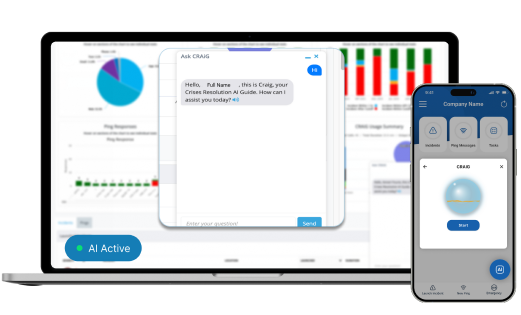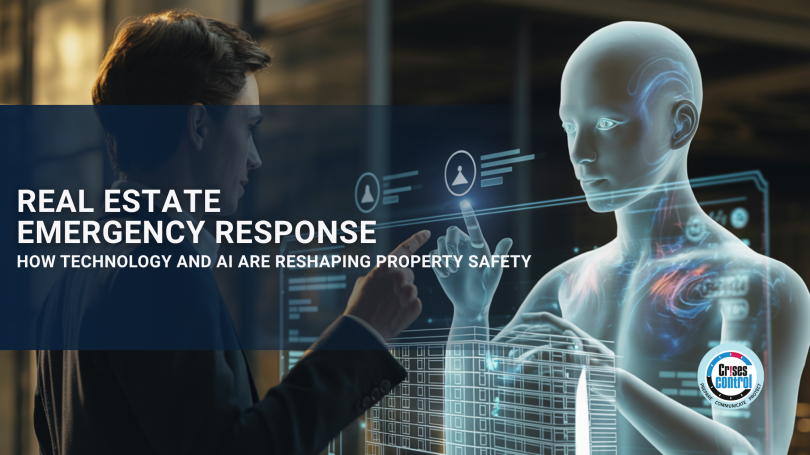Written by Anneri Fourie | Crises Control Executive
Real Estate Emergency Response: Smarter, Faster, Safer
Property managers and building owners deal with a unique challenge: protecting both people and assets. A fire, flood, gas leak, or security breach can cause injuries, disrupt operations, and damage trust. Traditional emergency plans, often built around phone trees or manual coordination, can leave too much room for error.
The problem is speed and communication. When something goes wrong, every second of delay increases risk. The solution is to bring automation, data, and intelligence into emergency response planning. With the right tools, incidents can be managed, contained, and resolved far more effectively.
Crises Control provides the digital foundation for that change. Its real estate emergency management software brings together mass notification, incident tracking, and AI-powered analysis to help property professionals protect their tenants, staff, and assets.
Technology in Real Estate Emergency Response
The property sector faces complex risks. From multi-building portfolios to mixed-use developments, keeping people safe across different sites is demanding. Relying on manual calls or email chains slows everything down when clarity is most needed.
Modern technology now offers a structured, digital way to prepare for and respond to emergencies. Platforms such as Crises Control give property teams complete control through features designed for both prevention and response.
Key benefits of using technology for emergency response:
- Unified communication: Instant alerts reach tenants, contractors, and emergency responders through SMS, email, voice, push, and desktop notifications.
- Real-time awareness: Dashboards display who is safe, where incidents are occurring, and which teams are responding.
- Data-led improvement: Every event generates insights that support regulatory reporting and future prevention.
- Compliance confidence: Digital audit trails prove that fire safety, health, and evacuation procedures are followed.
Digital systems replace guesswork with clear, fast communication and verified actions, helping property professionals stay in control.
The Role of AI in Property Emergency Management
Artificial intelligence is changing how property emergencies are detected and managed. Rather than waiting for a problem to occur, AI can recognise early warning signs and trigger pre-planned actions.
Crises Control’s AI Emergency Assistant, CRAiG, helps property managers respond faster and more effectively. By analysing live data and historical patterns, it guides users through each stage of an incident, ensuring no step is missed.
Here is how AI strengthens emergency management:
- Pattern recognition: Detects recurring issues, such as repeated alarm triggers or power faults, so teams can fix the root cause.
- Predictive alerts: Works with connected sensors to anticipate problems like leaks or overheating before they escalate.
- Action guidance: Suggests the best next step based on the nature of the incident, reducing decision pressure in high-stress situations.
- Automated messaging: Once an issue is confirmed, AI activates the correct communication plan instantly, ensuring everyone receives consistent and accurate information.
This partnership between human decision-making and machine intelligence creates faster responses, fewer mistakes, and stronger safety outcomes.
Interested in CRAiG?
CRAiG is the smart AI assistant built into the Crises Control Platform. It simplifies emergency management into a human conversation.

Why Real Estate Needs Dedicated Emergency Management Software
Generic communication tools are not enough for complex property portfolios. Real estate organisations need purpose-built emergency management software that reflects their operational and compliance needs.
Key capabilities include:
- Centralised control: Manage incidents across multiple properties from one secure portal.
- Accountability tracking: Record who has received, opened, and acknowledged each message.
- Maintenance and audit logs: Document drills, inspections, and corrective actions to support regulatory compliance.
- Custom response plans: Configure workflows for residential, commercial, or industrial buildings.
Crises Control’s real estate emergency management software combines all these elements within a secure, cloud-based system that meets international data protection standards. The result is a connected network of people and information that works seamlessly when emergencies arise.
Best Technology for Property Emergency Communication
Effective communication is the foundation of any emergency response. Property teams must be able to reach everyone in seconds, confirm their safety, and coordinate next steps. The best technology for property emergency communication enables this through automation and accessibility.
Essential features include:
- Multi-channel alerts: Ensure messages reach recipients via their preferred method, whether that’s SMS, app notification, voice call, or email.
- Two-way messaging: Allow tenants or staff to confirm they are safe or request help directly through the system.
- Geo-targeting: Send location-specific alerts, such as only notifying people on a certain floor or in one building.
- Language flexibility: Share messages in multiple languages to ensure clarity across diverse tenant groups.
- System integration: Connect alarms, sensors, and access controls so that communication starts automatically when an event occurs.
Crises Control’s Mass Notification System delivers all these features. It provides guaranteed delivery through a resilient, global network and gives managers confirmation reports showing who received and responded to each alert.
Reducing Risk Through Automation and Integration
Automation reduces the chance of human error and speeds up recovery. When connected to other property systems, it ensures that each part of the response process supports the next.
Practical examples include:
- IoT connectivity: Smart building sensors detect temperature changes, leaks, or unauthorised entry and immediately trigger alerts.
- Linked maintenance systems: Automatically create work orders for follow-up actions, ensuring problems are fixed quickly.
- AI analysis: Uses data from past events to improve emergency planning and resource allocation.
- Cloud scalability: Enables central management of multiple properties without additional hardware or on-site servers.
These capabilities make operations smoother and more resilient, reducing downtime and speeding up the return to normal activities after a disruption.
Creating a Culture of Preparedness
Technology is most effective when paired with a strong culture of readiness. Everyone involved in property management, from on-site staff to contractors, should know their role during an emergency.
Practical steps to build preparedness:
- Run regular digital drills and review results in the system.
- Analyse response data to identify areas for improvement.
- Keep tenants informed about procedures and updates.
- Provide ongoing training supported by reminders and online resources.
Crises Control simplifies each of these steps. It lets teams schedule and track drills, store training records, and report on compliance. Over time, this builds confidence and consistency across the entire organisation.
Strategic Benefits for Property Owners and Investors
A modern emergency management system does more than protect people. It also strengthens the financial and operational health of a property portfolio.
Key business benefits include:
- Tenant retention: Clear communication and visible safety measures build trust and long-term loyalty.
- Insurance leverage: Demonstrating preparedness can support lower premiums and smoother claims.
- Continuity of operations: Faster recovery protects rental income and reputation.
- Regulatory assurance: Automated reports simplify engagement with regulators and auditors.
By combining safety, compliance, and communication, real estate owners gain an edge that extends beyond crisis response.
How Does AI Improve Real Estate Emergency Response?
AI improves real estate emergency response by identifying risks sooner and managing information faster than manual systems can. It analyses data from alarms, sensors, and previous incidents to recommend the right actions for every scenario. Crises Control’s AI Emergency Assistant, CRAiG, provides this capability by offering real-time support and automation when pressure is high.
The system’s intelligent workflows reduce confusion, coordinate multi-site responses, and keep everyone informed until the situation is under control.
Real Estate Emergency Response: The Crises Control Advantage
Crises Control brings together communication, automation, and AI intelligence in one unified platform. It helps property professionals move from reactive management to proactive safety planning.
Key strengths include:
- AI-powered assistant that guides response teams step by step.
- Mass notification tools to reach every stakeholder in seconds.
- Full incident reporting for audits and compliance checks.
- Scalable, cloud-based architecture suitable for organisations of any size.
These features give real estate teams confidence that they can handle emergencies efficiently and meet both operational and regulatory expectations.
Ready to Strengthen Your Property’s Emergency Response?
Real estate organisations face increasing expectations for safety, accountability, and speed. Adopting a technology-led emergency response approach is one of the most effective ways to meet these demands.
Crises Control offers an integrated solution that connects people, systems, and data into one reliable platform. It helps property managers move from reaction to prevention, improving safety and protecting both tenants and assets.
Book your free demo today to see how Crises Control can transform your approach to property emergency response.
Request a FREE Demo

